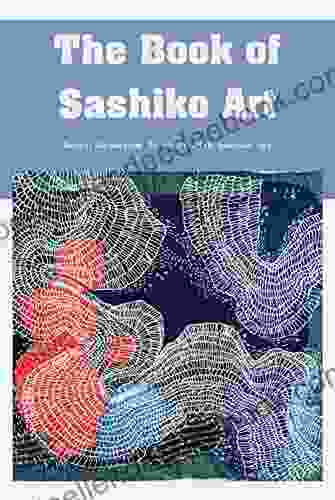Sashiko: The Art of Japanese Patchwork and Embroidery

Sashiko is a traditional Japanese form of embroidery and decorative stitching that has been used for centuries to repair and reinforce clothing and other textiles. The word "sashiko" literally means "little stabs" in Japanese, and the technique involves using a running stitch to create intricate patterns on fabric.
4.6 out of 5
| Language | : | English |
| File size | : | 38712 KB |
| Text-to-Speech | : | Enabled |
| Screen Reader | : | Supported |
| Enhanced typesetting | : | Enabled |
| Print length | : | 54 pages |
| Lending | : | Enabled |
Sashiko originated in northern Japan during the Edo period (1603-1868). At that time, cotton was becoming more widely available, and people began to use it to make clothing and other household items. However, cotton is a relatively delicate fabric, and it was often torn or damaged. Sashiko was developed as a way to repair and reinforce these items, and it quickly became a popular decorative art form as well.
Sashiko is typically done on indigo-dyed cotton fabric. The stitches are usually white, but they can also be dyed in other colors. The most common sashiko patterns are geometric, but there are also many free-form and floral designs. Sashiko can be used to create a variety of items, including clothing, quilts, tablecloths, and even artwork.
Sashiko is a relatively simple technique to learn, but it can be time-consuming to create large or intricate designs. The stitches are typically made by hand, but there are also machines that can be used to create sashiko patterns. Sashiko is a beautiful and versatile art form that can be used to create a variety of items. It is a traditional craft that is still popular today, and it continues to inspire contemporary artists and designers.
The Techniques of Sashiko Embroidery
Sashiko is a relatively simple stitch to learn, but it can be time-consuming to create large or intricate designs. The stitches are typically made by hand, using a running stitch. The needle is inserted into the fabric at a 45-degree angle, and the stitch is pulled through to the other side of the fabric. The needle is then inserted back into the fabric at a 45-degree angle on the other side of the previous stitch, and the stitch is pulled through to the other side of the fabric. This process is repeated until the desired pattern is created.
There are many different sashiko patterns, both geometric and free-form. Some of the most popular geometric patterns include the hemp leaf, the rice grain, and the wave. Free-form patterns can be anything from simple lines and curves to complex floral and animal designs.
Sashiko can be used to create a variety of items, including clothing, quilts, tablecloths, and even artwork. It is a versatile technique that can be used to create both functional and decorative items.
The Cultural Significance of Sashiko Embroidery
Sashiko is more than just a decorative art form. It is also a symbol of Japanese culture and heritage. Sashiko was originally used to repair and reinforce clothing and other textiles, and it was often passed down from generation to generation. This helped to create a sense of community and continuity within Japanese families and villages.
Sashiko is also a symbol of resilience and strength. The people of northern Japan have a long history of overcoming adversity, and sashiko has been a way for them to express their strength and determination. Sashiko patterns often incorporate symbols of good luck and protection, and they are often used to create items that are meant to last for many years.
Sashiko continues to be a popular art form in Japan today. It is used to create a variety of items, from traditional clothing to contemporary artwork. Sashiko is a beautiful and versatile art form that is rich in cultural significance.
Sashiko in Contemporary Art and Design
Sashiko is not only a traditional craft, but it is also a source of inspiration for contemporary artists and designers. Sashiko patterns and techniques have been incorporated into a variety of contemporary art forms, including painting, sculpture, and fashion.
One of the most famous contemporary artists who uses sashiko in her work is Yayoi Kusama. Kusama is known for her large-scale installations and sculptures, which often feature repetitive patterns and bright colors. Sashiko has been a major influence on Kusama's work, and she has used it to create a variety of pieces, including paintings, sculptures, and clothing.
Other contemporary artists who have been inspired by sashiko include Issey Miyake, Rei Kawakubo, and Yohji Yamamoto. These designers have used sashiko patterns and techniques to create a variety of clothing and accessories. Sashiko has also been used in interior design, product design, and even architecture.
Sashiko is a beautiful and versatile art form that continues to inspire contemporary artists and designers. It is a traditional craft with a rich cultural heritage, and it is also a source of inspiration for new and innovative works of art and design.
4.6 out of 5
| Language | : | English |
| File size | : | 38712 KB |
| Text-to-Speech | : | Enabled |
| Screen Reader | : | Supported |
| Enhanced typesetting | : | Enabled |
| Print length | : | 54 pages |
| Lending | : | Enabled |
Do you want to contribute by writing guest posts on this blog?
Please contact us and send us a resume of previous articles that you have written.
 Book
Book Chapter
Chapter Story
Story Genre
Genre Library
Library E-book
E-book Newspaper
Newspaper Sentence
Sentence Bookmark
Bookmark Shelf
Shelf Glossary
Glossary Bibliography
Bibliography Foreword
Foreword Preface
Preface Footnote
Footnote Scroll
Scroll Bestseller
Bestseller Classics
Classics Biography
Biography Memoir
Memoir Reference
Reference Encyclopedia
Encyclopedia Dictionary
Dictionary Narrator
Narrator Character
Character Stacks
Stacks Archives
Archives Study
Study Academic
Academic Journals
Journals Reading Room
Reading Room Rare Books
Rare Books Special Collections
Special Collections Interlibrary
Interlibrary Literacy
Literacy Study Group
Study Group Storytelling
Storytelling Awards
Awards Book Club
Book Club Textbooks
Textbooks Brett Callwood
Brett Callwood Sarah Birch
Sarah Birch Chi Young Kim
Chi Young Kim Tony Bacon
Tony Bacon Walter Pitman
Walter Pitman Jamie Thomas
Jamie Thomas Stephen Hess
Stephen Hess Matthew R Walsh
Matthew R Walsh Robert Chao Romero
Robert Chao Romero Sadeqa Johnson
Sadeqa Johnson Craig Briggs
Craig Briggs Shilpa Thotli
Shilpa Thotli Louise Fein
Louise Fein Alison Mcnicol
Alison Mcnicol Ellie Cummins
Ellie Cummins Jason Toynbee
Jason Toynbee Cormac Russell
Cormac Russell Layla Jones
Layla Jones Christopher C Tubbs
Christopher C Tubbs Kerstin Cordes
Kerstin Cordes
Light bulbAdvertise smarter! Our strategic ad space ensures maximum exposure. Reserve your spot today!

 Matt ReedReach Your Own Digital Marketing Success: A Comprehensive Guide to Dominating...
Matt ReedReach Your Own Digital Marketing Success: A Comprehensive Guide to Dominating... Billy FosterFollow ·10.7k
Billy FosterFollow ·10.7k Gabriel Garcia MarquezFollow ·19.3k
Gabriel Garcia MarquezFollow ·19.3k Banana YoshimotoFollow ·19.1k
Banana YoshimotoFollow ·19.1k Thomas HardyFollow ·19.9k
Thomas HardyFollow ·19.9k Samuel Taylor ColeridgeFollow ·13k
Samuel Taylor ColeridgeFollow ·13k Benjamin StoneFollow ·2.5k
Benjamin StoneFollow ·2.5k Lee SimmonsFollow ·11k
Lee SimmonsFollow ·11k W.B. YeatsFollow ·5.5k
W.B. YeatsFollow ·5.5k

 Brian Bell
Brian BellClassic Festival Solos Bassoon Volume Piano...
The Classic Festival Solos Bassoon Volume...

 Aubrey Blair
Aubrey BlairUnveiling the Courage: Insurgent Women Female Combatants...
In the face of armed...

 Jan Mitchell
Jan MitchellFor The Liberty Of Texas: The Lone Star State's Fight for...
The Republic of Texas was a sovereign state...

 Edgar Allan Poe
Edgar Allan PoeVisible, Explainable, Trustworthy, and Transparent...
What is VET2...
4.6 out of 5
| Language | : | English |
| File size | : | 38712 KB |
| Text-to-Speech | : | Enabled |
| Screen Reader | : | Supported |
| Enhanced typesetting | : | Enabled |
| Print length | : | 54 pages |
| Lending | : | Enabled |














